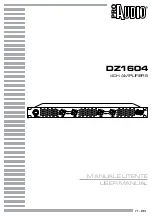
www.prolight.co.uk
CD Series Amplifiers
User Manual
5
Rear panel
01 -
These balanced XLR outputs can be used to pass
through the signal to additional power amplifiers.
02 -
XLR inputs - These inputs allow you to connect balanced
XLR plugs. These are wired with pin 2 hot, pin 3 cold and
pin 1 ground
03 -
There are two ways of connecting your speakers:
Locking speaker connectors or binding posts.
The connectors are wired in parallel. (e.g. Channel 1
binding post and locking speaker connectors are in
parallel and the same for channel 2).
When the amplifier is used in bridged mono mode use
the output bridge locking speaker connector or the two
red binding posts.
04 -
Locking power socket - This is where you connect the
detachable locking power cable. Connect the other end
to a 220-240V, 50/60Hz AC outlet.
05 -
Amp mode - This switch determines the input signal
routing within the amplifier. For most applications stereo
will be used.
Stereo mode - This is the "normal" way of using the
amplifier, in which each channel is fully independent.
Separate signals connect at the inputs, the gain knobs
control their respective channels, and separate speakers
connect to each output.
Examples:
• Two-channel (stereo) playback.
• Two independent mono signals, such as main and
monitor mixes.
• Bi-amped operation, with the low frequencies in
Channel 1 and the highs in Channel 2.
Parallel mode - This mode is just like Stereo mode,
except that the inputs for Channel 1 and Channel 2 are
internally connected together. A signal into any input
jack will therefore drive both channels directly. Each
channel's gain control still functions as usual, and each
channel feeds its own speaker load. You can patch the
input signal on to additional amplifiers by using any of
the remaining input jacks.
Example:
• One mono signal driving both channels, with
independent gain control for each speaker system.
Bridge mode - This mode combines the full power
capabilities of both channels into a single speaker
system. The amplifier internally re-configures so that
both channels operate as a unit. This delivers double the
output voltage, resulting in four times the peak power
and three times the sustained power into a single 8- or
4-ohm speaker load. Connections for bridge mono mode
are different to those used in Stereo or Parallel mode.
Examples:
• Driving a single 8-ohm speaker with the combined
4-ohm power of both channels.
• Driving a single 4-ohm speaker with the combined
2-ohm power of both channels.
Precautions: Bridge Mono mode makes it possible
to drive thousands of watts into a single speaker.
AC current consumption will usually be higher. Avoid
excessive signal level, and make sure the wiring and
speaker can handle the power.
06 -
The Gain sets the input sensitivity of the amplifier
dependant on the signal being sent from the pre-amp or
mixer etc.
07 -
The low cut filter rolls off signals below either 30Hz or
50Hz. This improves bass performance by limiting sub-
audio cone movement. As a rule, full range speakers
will sound better with the filtering activated. The 50Hz
filter works well with most compact full-range speakers,
and has a slight boost at 100Hz for greater fullness.
The 30Hz filter is intended for subwoofers and large
full-range cabinets. The "off" position should be used
only for applications such as studio playback monitoring,
where you need to know if there are unwanted sub-audio
signals present in your mix.
08 -
Circuit breaker - If the amplifier is over driven or a
serious problem occurs the resettable circuit breaker
may be activated. Push to reset the circuit breaker
when necessary to restore power to the amplifier. If the
breaker will not reset, contact your nearest authorised
repair centre for assistance.
05
01
02
06
08
04
07
03


























